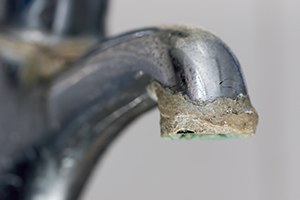
The corrosion of pipes and plumbing fixtures can cause a bevy of problems with your water. Corrosion is the gradual decomposition or destruction of a material by oxidation or chemical actions*, often due to an electrochemical reaction. Corrosion starts at the surface or a material and moves inward. Corrosion of iron or steel is commonly called rusting. A number of factors will accelerate corrosion, including:
- Acidity (low pH)
- High mineral concentrations
- Stray current electrolysis
- Galvanic corrosion caused by dissimilar metals
- Dissolved oxygen content
- Water temperatures
Water treatment can improve corrosion issues.
The following types of water treatment solutions are recommended:
- Limestone chip filters
- Soda ash feeds
- Phosphate solution feeds
- Silicate solution feeds
- Oxygen scavengers
- Coatings
- Insulating unions
Click here to find a water treatment provider who can help solve corrosion issues.
Click here to find products certified by WQA for the reduction of corrosion byproducts such as copper or lead (Certified to NSF/ANSI Standard 53 or 58).
*Cation Exchange water softeners neither cause nor prevent corrosion. Corrosion is caused by a change in the pH or carbon dioxide concentration, the dissolved oxygen concentration, or the total chemical concentration of minerals. None of these factors is affected by water softeners. This was validated by a U.S. EPA pilot study conducted by Thomas J. Sorg and Michael R. Schock of the EPA’s Drinking Water Research Division. (Leaching of Metals from Household Plumbing Materials: Impact of Home Water Softener Study).
